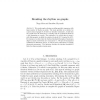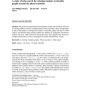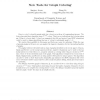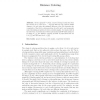27 search results - page 2 / 6 » Coloring Geographical Threshold Graphs |
DM
2008
13 years 4 months ago
2008
We study graph colorings avoiding periodic sequences with large number of blocks on paths. The main problem is to decide, for a given class of graphs F, if there are absolute const...
JCT
2010
13 years 3 months ago
2010
We call a coloring of the edge set of a graph G a b-bounded coloring if no color is used more than b times. We say that a subset of the edges of G is rainbow if each edge is of a ...
IJAMCIGI
2010
13 years 4 days ago
2010
We present an experimental investigation of tabu search (TS) to solve the 3-coloring problem (3-COL). Computational results reveal that a basic TS algorithm is able to find proper ...
APPROX
2011
Springer
12 years 5 months ago
2011
Springer
How to color 3 colorable graphs with few colors is a problem of longstanding interest. The best polynomial-time algorithm uses n0.2072 colors. There are no indications that colori...
ESA
2007
Springer
13 years 11 months ago
2007
Springer
Given a graph G = (V, E), a (d, k)-coloring is a function from the vertices V to colors {1, 2, . . . , k} such that any two vertices within distance d of each other are assigned di...




